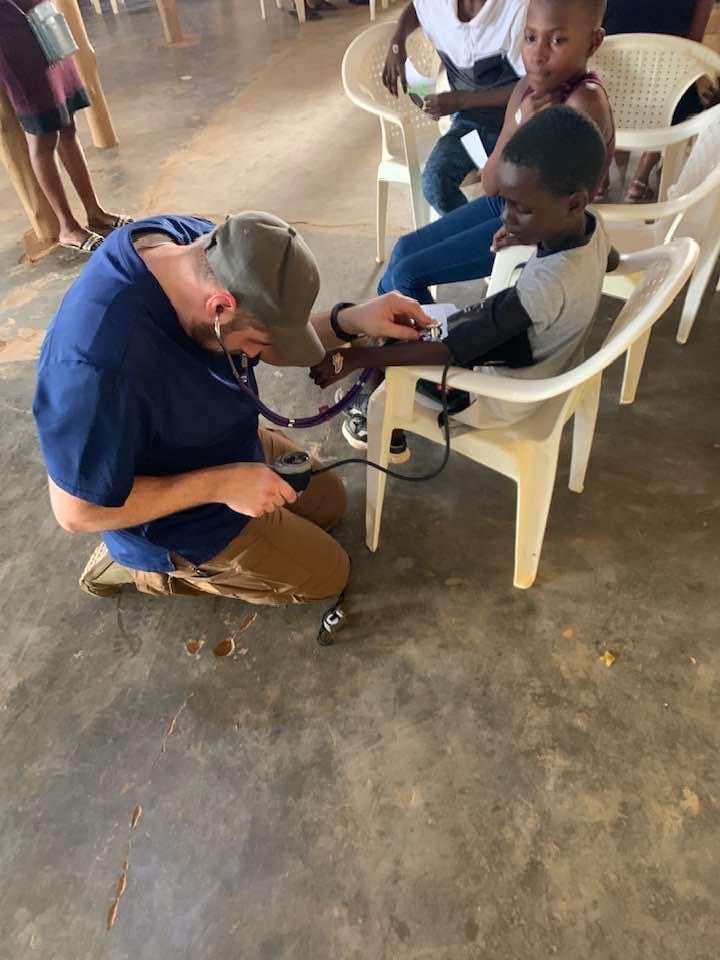
Clinics
Local advertising for clinic
● There is never a charge for patients to be seen in clinic or attend a class.
● Temporary clinics are set up in areas where healthcare resources are limited, both urban and rural.
● Clinics run 2-5 days in each area.
● Patients often travel long distances to be seen.
● Every team member is assigned an interpreter fluent in both English and the local dialect.
● There is never enough time to see all who seek care. On a typical clinic day, 100 - 150 patients are seen.
Intake / Triage
Pam Zahara triaging a patient
Child teaching handwashing
Sam Siebach taking child’s blood pressure while triaging
Group Education
Elijah, Ugandan Clinic Director, doing group education
Harriet Hawkins triaging a patient
Judy Ptak triaging with help from translators
There is no assignment of triage acuity to determine who is seen next but patients with emergent conditions are immediately taken to a provider.
Patients wait patiently to be seen. It is not uncommon for some to have to return the next day. While they are waiting, team members teach classes such as proper handwashing technique and malaria prevention to the group.
Patients are initially evaluated by nurses and EMTs who obtain basic information and vital signs.
Providers
Dr. Leanne Converse examining a patient at her home
Sam Siebach, EMT, cleaning the ears of patients
Dr. Richard Trierweiler and his interpreter waiting to see a patient
Each patient is evaluated by a volunteer provider (physician, nurse practitioner, physician’s assistant). Experienced nurses may also see patients for less complex conditions in consultation with a provider.
Local providers also volunteer to help staff the clinic. They are an invaluable resource regarding local conditions and how they are typically managed. In addition, they know about local resources for ongoing care.
Providers request diagnostic tests and prescribe treatments and education.
Many complaints are related to living circumstances such as eye irritation from poor air quality or back pain from bending at the waist to cook or dig in the fields.
Education is emphasized over medication whenever possible.
Nurse Practioner Chris Gisness examining a patient's eyes
Nurse Practitioner Trudy Roberts assessing a baby
Diagnostic Testing
Local laboratory professionals volunteer to do point-of-care testing with supplies purchased in country.
Malaria
Urinalysis
Urine pregnancy
Syphilis (RPR)
Blood glucose
Patients may be sent to a local health care facility for diagnostic testing that cannot be performed in clinic. We typically pay 80% of the cost of the test and the patient/family covers the balance.
Discharge Teaching
Education Guides for team and interpreters
Judy Ptak discussing discharge instructions to the mother of a sick child
Every patient attends a discharge teaching session for education as prescribed by the provider.
Nurses use the Health • Education • Empowerment Community & Patient Education Guides to provide consistent, evidence-based information.
Basic health promotion and prevention information is emphasized.
Educational posters hung in areas where patients are waiting
Harriet Hawkins providing discharge education
Pharmacy
Pharmacy Supplies
There is no charge for medications dispensed by the clinic.
Medications are purchased locally and dispensed as prescribed by the providers.
Non-pharmacologic options are provided whenever possible.
Medications for management of chronic conditions such as diabetes, high blood pressure, etc. are not prescribed or provided. These patients are instructed to follow up with a local healthcare provider for long term management.
Team Leader Jean Proehl with Evelyn Nakimuli who has worked in the pharmacy with the team for many years. Evelyn’s nursing education was funded by an H.E.E. team member.



























